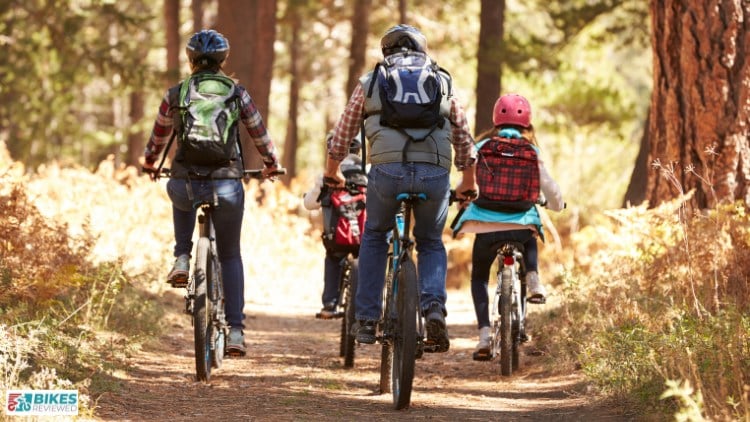Mountain biking is an exhilarating outdoor activity that combines adrenaline, adventure, and a connection with nature.
Whether you're a newbie looking to hit the trails for the first time or someone who's been riding for a while but wants to refine their skills, getting started with mountain biking requires some essential know-how.
Let's break down the fundamentals of how to start mountain biking?, from choosing the right bike to mastering basic techniques and staying safe on the trails.

Choosing the Right Bike
Before you hit the trails, it's essential to choose a mountain bike that suits your needs and riding style. Here's what to consider:
- Types of Mountain Bikes: There are various types of mountain bikes, including cross-country (XC), trail, enduro, and downhill bikes. Each type is designed for specific terrain and riding styles, so choose one that aligns with your preferences and the type of trails you'll be riding on.
- Bike Size and Fit: Ensuring your mountain bike fits you properly is crucial for comfort and control. Visit a local bike shop to get professionally fitted or use sizing charts provided by bike manufacturers to find the right mountain bike size for your height and inseam.
- Budget: Mountain bikes come in a wide range of prices, so determine your budget before making a purchase. While it's tempting to go for the most expensive option, there are plenty of quality bikes available at lower price points for beginners.
- Test Rides: Before making a final decision, take potential bikes for test rides to get a feel for how they handle and whether they're comfortable for you. Pay attention to factors like frame material, suspension, and gear shifting.
Essential Gears and Equipment's For Mountain Biking
In addition to a mountain bike, there are several pieces of gear and equipment you'll need to ensure a safe and enjoyable ride:
- Helmet: A properly fitting helmet is non-negotiable when it comes to mountain biking. Choose one that meets safety standards and provides adequate protection for your head.
- Appropriate Clothing: Wear moisture-wicking clothing that allows for freedom of movement and provides protection from the elements. Consider investing in padded shorts for added comfort during long rides.
- Footwear: Choose flat or clipless mountain bike shoes with grippy soles to ensure good pedal traction and control.
- Gloves: Cycling gloves can help protect your hands from blisters and provide extra grip on the handlebars, especially in wet conditions.
- Eyewear: Sunglasses or clear lenses can shield your eyes from debris and UV rays while riding.
- Repair Kit: Carry a basic repair kit with essentials like a spare tube, tire levers, multitool, and a mini-pump or CO2 inflator to handle common mechanical issues on the trail.
Mastering Basic Techniques
Once you have your bike and gear sorted, it's time to learn some basic mountain biking techniques:
- Body Position: Maintain a balanced and centered position on the bike with your knees and elbows slightly bent. Keep your weight centered over the bike's frame to improve stability and control.
- Braking: Use both your front and rear brakes together for optimal stopping power. Apply gradual pressure to avoid skidding, especially on loose or slippery terrain.
- Shifting Gears: Anticipate changes in terrain and shift gears accordingly to maintain a comfortable cadence. Practice shifting smoothly and efficiently to avoid gear grinding or chain drops.
- Climbing and Descending: When climbing, shift into an easier gear and keep a steady pace to conserve energy. Descend with confidence by staying loose on the bike, looking ahead at the trail, and using your body to absorb bumps and obstacles.
- Cornering: Approach corners with controlled speed and lean your bike into the turn while keeping your body upright. Look through the turn and use your outside foot to weigh the pedals for better traction.
Trail Etiquette and Safety Tips
Mountain biking is not only about riding skills but also about respecting the trails and other trail users. Follow these etiquette and safety tips:
- Yield to Other Trail Users: Always yield to hikers, runners, and equestrians on the trail. Slow down and announce your presence when passing, and be courteous to other users.
- Stay on Designated Trails: Respect trail closures and avoid riding in sensitive or protected areas. Stick to marked trails to minimize environmental impact and preserve natural habitats.
- Pack Out What You Pack In: Practice Leave No Trace principles by carrying out your trash and disposing of it properly. Avoid littering or disturbing wildlife while out on the trails.
- Ride Within Your Limits: Know your skill level and ride within your abilities. Pushing yourself too hard on challenging trails can lead to accidents and injuries.
- Be Prepared: Before heading out on a ride, check the weather forecast, inform someone of your plans, and carry essentials like water, snacks, and a map or GPS device.
By following these tips and techniques, you'll be well on your way to enjoying the thrill and excitement of mountain biking while staying safe and responsible on the trails. Remember to start slowly, practice regularly, and most importantly, have fun exploring the great outdoors on two wheels!
